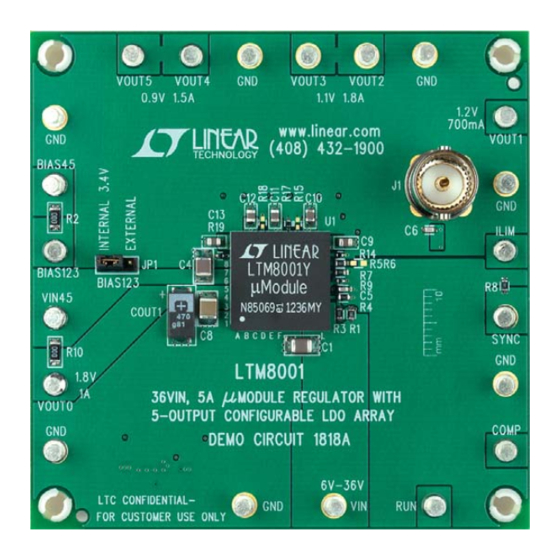
Advertisement
DESCRIPTION
Demo circuit 1818A features the LTM8001 μModule regula-
tor that includes a 5A switching regulator and an array of
five 1.1A low noise LDOs. DC1818A is configured so the
switching regulator provides an output that also powers
the LDOs. The LDOs in turn provide three outputs – one
from a single LDO and two outputs each formed by paral-
leling two LDOs together.
DC1818A supports changes to the LTM8001's user adjust-
able features including the output voltage of the switching
regulator, output voltage of each of the five LDOs, switching
frequency, soft-start period and output current limit of the
BOARD PHOTO
Arrow.com.
Downloaded from
DEMO MANUAL DC1818A
36V
, 5A µModule Regulator with
IN
5-Output Configurable LDO Array
switching regulator simply by modifying the appropriate
resistors or capacitor. DC1818A also supports all current
sharing or independent operation options of the LDOs.
DC1818A includes a BNC connector for noise measure-
ment of the LDO for V
further reduces output noise.
The LTM8001 data sheet must be read in conjunction with
this demo manual to properly use or modify DC1818A.
Design files for this circuit board are available at
http://www.linear.com/demo
L, LT, LTC, LTM, Linear Technology, the Linear logo and μModule are registered trademarks of
Linear Technology Corporation. All other trademarks are the property of their respective owners.
Specifications are at T
= 25°C
A
LTM8001
. An optional capacitor at C14
OUT1
dc1818af
1
Advertisement
Table of Contents

Summary of Contents for Linear Technology DC1818A
- Page 1 L, LT, LTC, LTM, Linear Technology, the Linear logo and μModule are registered trademarks of Linear Technology Corporation. All other trademarks are the property of their respective owners. BOARD PHOTO Specifications are at T = 25°C...
-
Page 2: Performance Summary
1. Place JP1 for BIAS123 in the INTERNAL 3.4V position. other parameters. NOTE: DC1818A includes an LTM8020 regulator to provide 3.4V bias voltages to the LDOs. The 3.4V bias supply can be disconnected using jumper JP1 to allow an external bias supply. - Page 3 DEMO MANUAL DC1818A QUICK START PROCEDURE Figure 1. Proper Measurement Equipment Setup dc1818af Arrow.com. Arrow.com. Arrow.com. Downloaded from Downloaded from Downloaded from...
- Page 4 DEMO MANUAL DC1818A QUICK START PROCEDURE –20 –40 –60 –80 –100 –120 FREQUENCY (MHz) dc1881a F02 Figure 2. V Noise Spectrum (V = 1.2V at 700mA, C = 22μF, C = 1nF, V = 12V, OUT1 OUT1 OUT1 SET1 = 1.8V Loaded to a Total Current of 5A) OUT0 Figure 3.
-
Page 5: Parts List
DEMO MANUAL DC1818A PARTS LIST ITEM REFERENCE PART DESCRIPTION MANUFACTURER/PART NUMBER Required Circuit Components COUT1 CAP., POSCAP, 470μF, 4V, D3L SANYO, 4TPE470ML Cap., X5R, 10μF, 50V, 20% 1210 TAIYO YUDEN, UMK325BJ106M Cap., X7R, 1000pF, 50V, 20% 0603 AVX, 06035C102MAT2A Cap., X5R, 100μF, 6.3V, 20%, 1210... -
Page 6: Schematic Diagram
DEMO MANUAL DC1818A SCHEMATIC DIAGRAM dc1818af Arrow.com. Arrow.com. Arrow.com. Arrow.com. Arrow.com. Arrow.com. Downloaded from Downloaded from Downloaded from Downloaded from Downloaded from Downloaded from... - Page 7 Information furnished by Linear Technology Corporation is believed to be accurate and reliable. However, no responsibility is assumed for its use. Linear Technology Corporation makes no representa- tion that the interconnection of its circuits as described herein will not infringe on existing patent rights.
- Page 8 Linear Technology Corporation (LTC) provides the enclosed product(s) under the following AS IS conditions: This demonstration board (DEMO BOARD) kit being sold or provided by Linear Technology is intended for use for ENGINEERING DEVELOPMENT OR EVALUATION PURPOSES ONLY and is not provided by LTC for commercial use. As such, the DEMO BOARD herein may not be complete in terms of required design-, marketing-, and/or manufacturing-related protective considerations, including but not limited to product safety measures typically found in finished commercial goods.













Need help?
Do you have a question about the DC1818A and is the answer not in the manual?
Questions and answers